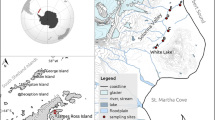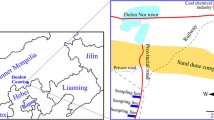Abstract
This study provides a seasonal elemental characterisation of native lichens collected in rural areas of Portugal affected by charcoal kilns, using nuclear analytical techniques and electric conductivity. In autumn, it was possible to identify high levels of electric conductivity near the site with charcoal kilns due to higher oxidative stress of the lichens’ membrane. Typical chemical elements associated with emissions of wood burning, such as S and P, also presented the highest contents near the charcoal kilns. However, the same phenomenon was not found in spring. Residential areas presented the highest levels of S and P probably due to the impact of biomass burning from home heating that occurred during the winter period. Overall, lichens were found to be enriched with elements that can be attributable to non-crustal sources, namely, sea salt spray (Cl and Na), fertilisers used in agriculture (P and Ca) and wood burning (P and S).





Similar content being viewed by others
References
Sparrevik M, Adam C, Martinsen V et al (2015) Emissions of gases and particles from charcoal/biochar production in rural areas using medium-sized traditional and improved “retort” kilns. Biomass Bioenergy 72:65–73. https://doi.org/10.1016/j.biombioe.2014.11.016
Faé Gomes GM, Encarnação F (2012) The environmental impact on air quality and exposure to carbon monoxide from charcoal production in southern Brazil. Environ Res 116:136–139. https://doi.org/10.1016/j.envres.2012.03.012
de Carvalho AB, Kato M, Rezende MM et al (2008) Determination of carbonyl compounds in the atmosphere of Charcoal plants by HPLC and UV detection. J Sep Sci 31:1686–1693. https://doi.org/10.1002/jssc.200800006
de Carvalho AB, Kato M, Rezende MM et al (2013) Exposure to carbonyl compounds in charcoal production plants in Bahia, Brazil. Environ Sci Pollut Res 20:1565–1573. https://doi.org/10.1007/s11356-012-1243-z
FAOSTAT (2018) FAOSTAT. http://www.fao.org/faostat/en/#search/charcoal. Accessed 16 Nov 2018
Canha N, Lage J, Galinha C et al (2018) Avaliação do impacte da produção tradicional de carvão na qualidade do ar através de biomonitorização. In: Livro de Actas “Uso Sustentável dos Ecossistemas e Proteção da Biodiversidade”—Conferência Internacional de Ambiente em Língua Portuguesa, XX Encontro REALP, XI CNA. Aveiro, Portugal, Portugal, pp 490–499
Brito JO (1990) Princípios de produção e utilização de carvão vegetal de madeira. In: Instituto de Pesquisas e Estudos Florestais (ed), São Paulo, p 14
Olujimi OO, Ana GREE, Ogunseye OO, Fabunmi VT (2016) Air quality index from charcoal production sites, carboxyheamoglobin and lung function among occupationally exposed charcoal workers in South Western Nigeria. Springerplus 5:1546. https://doi.org/10.1186/s40064-016-3227-9
Pereira EG, Martins MA, Pecenka R, Angélica de Cássia CO (2017) Pyrolysis gases burners: sustainability for integrated production of charcoal, heat and electricity. Renew Sustain Energy Rev 75:592–600. https://doi.org/10.1016/j.rser.2016.11.028
Gerdol R, Marchesini R, Iacumin P, Brancaleoni L (2014) Monitoring temporal trends of air pollution in an urban area using mosses and lichens as biomonitors. Chemosphere 108:388–395. https://doi.org/10.1016/j.chemosphere.2014.02.035
Protano C, Owczarek M, Antonucci A et al (2017) Assessing indoor air quality of school environments: transplanted lichen Pseudovernia furfuracea as a new tool for biomonitoring and bioaccumulation. Environ Monit Assess 189:358. https://doi.org/10.1007/s10661-017-6076-2
Almeida SM, Lage J, Freitas MDC et al (2012) Integration of biomonitoring and instrumental techniques to assess the air quality in an industrial area located in the coastal of central Asturias, Spain. In: Journal of toxicology and environmental health—part A: current issues, Taylor & Francis Group, pp 1392–1403
Boonpeng C, Polyiam W, Sriviboon C et al (2017) Airborne trace elements near a petrochemical industrial complex in Thailand assessed by the lichen Parmotrema tinctorum (Despr. ex Nyl.) Hale. Environ Sci Pollut Res 24:12393–12404. https://doi.org/10.1007/s11356-017-8893-9
Vieira BJ, Freitas MC, Wolterbeek HT (2017) Vitality assessment of exposed lichens along different altitudes. Influence of weather conditions. Environ Sci Pollut Res 24:1–7. https://doi.org/10.1007/s11356-016-6868-x
Canha N, Almeida-Silva M, Freitas MC et al (2012) Lichens as biomonitors at indoor environments of primary schools. J Radioanal Nucl Chem 291(1):123–128
Godinho RM, Verburg TG, Freitas MC, Wolterbeek HT (2009) Accumulation of trace elements in the peripheral and central parts of two species of epiphytic lichens transplanted to a polluted site in Portugal. Environ Pollut 157:102–109. https://doi.org/10.1016/j.envpol.2008.07.021
Lage J, Wolterbeek HT, Reis MA et al (2016) Source apportionment by positive matrix factorization on elemental concentration obtained in PM10 and biomonitors collected in the vicinities of a steelworks. J Radioanal Nucl Chem 309:397–404. https://doi.org/10.1007/s10967-016-4751-3
Fränzle O (2003) Chapter 2 bioindicators and environmental stress assessment. Trace Met other Contam Environ 6:41–84. https://doi.org/10.1016/S0927-5215(03)80132-7
Markert BA, Breure AM, Zechmeister HG (2003) Chapter 1 definitions, strategies and principles for bioindication/biomonitoring of the environment. Trace Met other Contam Environ 6:3–39. https://doi.org/10.1016/S0927-5215(03)80131-5
Cruz AMJ, Freitas M, do C, Canha N et al (2012) Spatial mapping of the city of Lisbon using biomonitors. Int J Environ Heal 6:1. https://doi.org/10.1504/IJENVH.2012.046852
Machado A, Šlejkovec Z, Elteren JT et al (2006) Arsenic speciation in transplanted lichens and tree bark in the framework of a biomonitoring scenario. J Atmos Chem 53:237–249. https://doi.org/10.1007/s10874-006-9013-2
Leonardo L, Damatto SR, Gios BR, Mazzilli BP (2014) Lichen specie Canoparmelia texana as bioindicator of environmental impact from the phosphate fertilizer industry of São Paulo, Brazil. J Radioanal Nucl Chem 299:1935–1941. https://doi.org/10.1007/s10967-013-2887-y
Loppi S, Bonini I (2000) Lichens and mosses as biomonitors of trace elements in areas with thermal springs and fumarole activity (Mt. Amiata, central Italy). Chemosphere 41:1333–1336. https://doi.org/10.1016/S0045-6535(00)00026-6
Bubach D, Dufou L, Catán SP (2014) Evaluation of dispersal volcanic products of recent events in lichens in environmental gradient, Nahuel Huapi National Park, Argentina. Environ Monit Assess 186:4997–5007. https://doi.org/10.1007/s10661-014-3754-1
Bermejo-Orduna R, McBride JR, Shiraishi K et al (2014) Biomonitoring of traffic-related nitrogen pollution using Letharia vulpina (L.) Hue in the Sierra Nevada, California. Sci Total Environ 490:205–212. https://doi.org/10.1016/j.scitotenv.2014.04.119
Paatero J, Jaakkola T, Kulmala S (1998) Lichen (sp. Cladonia) as a deposition indicator for transuranium elements investigated with the Chernobyl fallout. J Environ Radioact 38:223–247. https://doi.org/10.1016/S0265-931X(97)00024-6
Augusto S, Pereira MJ, Soares A, Branquinho C (2007) The contribution of environmental biomonitoring with lichens to assess human exposure to dioxins. Int J Hyg Environ Health 210:433–438. https://doi.org/10.1016/j.ijheh.2007.01.017
Canha N, Almeida SM, Freitas MC, Wolterbeek HT (2014) Indoor and outdoor biomonitoring using lichens at urban and rural primary schools. J Toxicol Environ Heal Part A Curr Issu 77:900–915. https://doi.org/10.1080/15287394.2014.911130
Bozkurt Z (2017) Determination of airborne trace elements in an urban area using lichens as biomonitor. Environ Monit Assess 189:573. https://doi.org/10.1007/s10661-017-6275-x
Gür F, Yaprak G (2011) Biomonitoring of metals in the vicinity of Soma coal-fired power plant in western Anatolia, Turkey using the epiphytic lichen, Xanthoria parietina. J Environ Sci Heal Part A Toxic Hazard Subst Environ Eng 46:1503–1511. https://doi.org/10.1080/10978526.2011.609075
Revay Z (2015) PGAA: prompt gamma and in-beam neutron activation analysis facility. J Largescale Res Facil JLSRF 1:A20. https://doi.org/10.17815/jlsrf-1-46
Révay Z, Kudejova P, Kleszcz K et al (2015) In-beam activation analysis facility at MLZ, garching. Nucl Instrum Methods A 799:114–123
Révay Z, Belgya T, Molnár GL (2005) Application of hypermet-PC in PGAA. J Radioanal Nucl Chem 265:261–265
Molnar GL, Révay Z, Belgya T (2002) Wide energy range efficiency calibration method for Ge detectors. Nucl Instrum Methods A 489:140–159
Révay Z (2009) Determining elemental composition using prompt gamma activation analysis. Anal Chem 81:6851–6859. https://doi.org/10.1021/ac9011705
Armishaw P, King B, Millar RG (2003) Achieving traceability in chemical measurement: a metrological approach to proficiency testing. In: Accreditation and quality assurance, pp 184–190
Canha N, Freitas MDC, Almeida SM (2019) Contribution of short irradiation instrumental neutron activation analysis to assess air pollution at indoor and outdoor environments using transplanted lichens. J Radioanal Nucl Chem 320:129–137. https://doi.org/10.1007/s10967-019-06461-5
Marques AP, Freitas MC, Wolterbeek HT et al (2005) Cell-membrane damage and element leaching in transplanted Parmelia sulcata lichen related to ambient SO2, temperature, and precipitation. Environ Sci Technol 39:2624–2630. https://doi.org/10.1021/es0498888
Canha N, Freitas MC, Almeida-Silva M et al (2012) Burn wood influence on outdoor air quality in a small village: foros de Arrão, Portugal. J Radioanal Nucl Chem 291(1):83–88
Shi J, Wang N, Gao H et al (2019) Phosphorus solubility in aerosol particles related to particle sources and atmospheric acidification in Asian continental outflow. Atmos Chem Phys 19:847–860. https://doi.org/10.5194/acp-19-847-2019
Calvo AI, Alves C, Castro A et al (2013) Research on aerosol sources and chemical composition: past, current and emerging issues. Atmos Res 120–121:1–28
Canha N, Freitas MC, Pacheco AMG (2013) Response of air-pollution biomonitors under three different meteorological conditions. J Radioanal Nucl Chem 295:489–496. https://doi.org/10.1007/s10967-012-1918-4
Justino AR, Canha N, Gamelas C et al (2019) Contribution of micro-PIXE to the characterization of settled dust events in an urban area affected by industrial activities. J Radioanal Nucl Chem 322:1953–1964. https://doi.org/10.1007/s10967-019-06860-8
Canha N, Dionisio I, Freitas MC et al (2011) Elemental characterization of superficial waters contaminated by an abandoned sulfide-mining area. Proc Radiochim Acta 1:377–381. https://doi.org/10.1524/rcpr.2011.0067
Mason B, Moore CB (1982) Principles of Geochemistry. Wiley, New York
Dexter SC, Dalrymple RA, Kobayashi N (1988) The marine environment. In: Materials for marine systems and structures, Academic Press, Inc., pp 35–87
Lobert JM, Keene WC, Logan JA, Yevich R (1999) Global chlorine emissions from biomass burning: reactive chlorine emissions inventory. J Geophys Res Atmos 104:8373–8389. https://doi.org/10.1029/1998JD100077
Osyczka P, Boroń P, Lenart-Boroń A, Rola K (2018) Modifications in the structure of the lichen Cladonia thallus in the aftermath of habitat contamination and implications for its heavy-metal accumulation capacity. Environ Sci Pollut Res 25:1950–1961. https://doi.org/10.1007/s11356-017-0639-1
Canha N, Almeida SM, Freitas MDC et al (2014) Particulate matter analysis in indoor environments of urban and rural primary schools using passive sampling methodology. Atmos Environ 83:21–34. https://doi.org/10.1016/j.atmosenv.2013.10.061
Schlesinger WH, Klein EM, Vengosh A (2017) Global biogeochemical cycle of vanadium. Proc Natl Acad Sci USA 114:E11092–E11100. https://doi.org/10.1073/pnas.1715500114
Acknowledgements
N. Canha acknowledges the funding by national funds through FCT—Fundação para a Ciência e a Tecnologia, I.P. (Portugal) for his Postdoc Grant (SFRH/BPD/102944/2014) and his contract ISD-ID (IST-ID/098/2018). The FCT support is also gratefully acknowledged by C2TN/IST (UIDB/04349/2020 + UIDP/04349/2020) and by CESAM (UIDB/50017/2020 + UIDP/50017/2020). This work is based on experiments performed at the PGAA (PromptGamma Activation Analysis) instrument at the Heinz Maier-Leibnitz Zentrum (MLZ), Garching, Germany.
Author information
Authors and Affiliations
Corresponding author
Ethics declarations
Conflict of interest
The authors declare no conflicts of interest.
Additional information
Publisher's Note
Springer Nature remains neutral with regard to jurisdictional claims in published maps and institutional affiliations.
Rights and permissions
About this article
Cite this article
Canha, N., Justino, A.R., Galinha, C. et al. Elemental characterisation of native lichens collected in an area affected by traditional charcoal production. J Radioanal Nucl Chem 325, 293–302 (2020). https://doi.org/10.1007/s10967-020-07224-3
Received:
Published:
Issue Date:
DOI: https://doi.org/10.1007/s10967-020-07224-3




